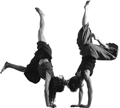The Kalarippayattu body and mental /spiritual training is very complete. It is an ancient beautiful art form, self-defense, and healing system. Different animal poses which are part of the fast sequences, are very deep, low and yet combined with dynamic high kicks and jumps. As in Yoga, subtle energy channels are opened, You meet your limits, your fears and learn to play with them.
Repetition is a key element, instinct too. You do not learn from a mental state, you absorb the knowledge through repetition and observation. The group energy is an important element of the work. Respect, hard work, and support. Awareness is opened, awakening skin, muscles, nerves and your perceptions of the space and people around you. That is the ideal state of the warrior, but also of a performer.
Regular Ayurvedic oil massages are given and received by each student and by the master. These help attain the flexibility and flow typical of Kalari: the training develops strength, stamina, flexibility, endurance, concentration, will power, and a flow of movement similar to a river. Weapons are taught gradually and bare hand fighting only at the very end, to the disciples who have proved themselves worthy. The students are first introduced to the wooden sticks, long, short, curved (each revealing special hidden hand techniques). Then there are 6 metal weapons, of which the last and most dangerous one is the Urumi, a long whip sword.
“Kalari Amsterdam” follows the teachings and style of great master E.P.Vasudeva Gurrukal. Some disciples have studied in his CVN kalari situated in the village of Kaduthuruty, Kerala, south India.
Brief history of Kalarippayat
Kalarippayat is one of the most ancient martial arts. It originates in Kerala, South India, and has been practised through the ages by woman and men, disciples from all religious backgrounds alike. History dates its origins to 1500 BC, but myths and legends mix in with history very playfully. The south indian prince called Ta Mo, gave up his kingdom and heritage to follow the path that would take him to Bouddhism. He is known under the name of: Bodhidharma. During his travels, he met great Kalari masters from whom he learnt the secrets of Kalarippayattu, which he later taught with his philosophy to the Shaolin monks.
During the middle ages, there was a certain caste, the Kshatriyas, whose duty was to fight to defend different kingdoms. Then came a ban from the british colonizers on its practice, therefore they needed to go incognito. Unfortunately as with Indian dance, part of the rich heritage was at risk of being lost. Thankfully, there was inner resistance and some people continued to practice and teach secretly.
The Kalari is a special place which resembles a temple: rituals with flower offerings, mantras, oil lamps, and hard work, from dawn to dusk, not only in the earth floor training space, but also in the small area reserved for patients who are treated for all kinds of ailments. The Kalari disciple who becomes a master “Guru”, with time becomes as well an Ayurvedic healer, a physiotherapist, a herbalist, doctor of the village. He detains almost all the secret vital point striking techniques of his own master.

